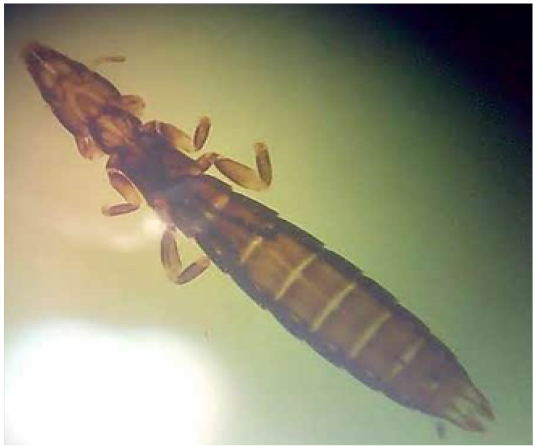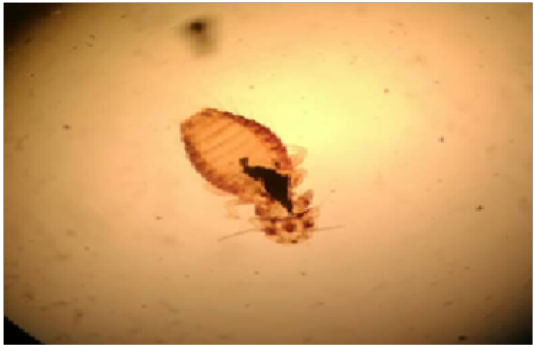Advances in Animal and Veterinary Sciences
Review Article
Isolation and Identification of Lice on Some Species of Columbidae Family
Suhad Yasin Jassim, Afkar Muslim Hadi*
Iraq Natural History Research Center and Museum, University of Baghdad, Baghdad Iraq.
Abstract | There are many species of chewing lice (Mallophaga) that regularly parasitize on birds causing many symptoms such as: general weakness, developmental atrophy of somepartsof body, itching, and discomfort as well as blood problems related to blood. Among the most important of these species: Columbicola columbae, Menopon gallinae, Goniocotes gallinae, Cuclutogaster heterographus and Menacanthus stramineus. In this study, authors were able to review most of the local and international studies related to the diagnosis (classification) of lice, especially those infested birds from some species of Columbidae family, The current study findings only two species of lice Columbi colacolumbae (Linnaeus 1758) and Menacanthus sp. (Neumann, 1912) from some species of Columbidae family in Baghdad city, Iraq. The aim of this study was to create a database and put an important reference for all researchers and authors whoplan to study this field more comprehensively in the future.
Keywords | Lice, Mallophaga, Phthiraptera, Columbidae, Menacanthus.
Received | April 03, 2019; Accepted | June 11, 2019; Published | August 27, 2019
*Correspondence | Afkar Muslim Hadi, Iraq Natural History Research Center and Museum, University of Baghdad, Baghdad Iraq; Email: afkar_hadi_iraq@yahoo.com
Citation | Jassim SY, Hadi AM (2019). Isolation and identification of lice on some species of columbidae family. Adv. Anim. Vet. Sci. 7(9): 806-809.
DOI | http://dx.doi.org/10.17582/journal.aavs/2019/7.9.806.809
ISSN (Online) | 2307-8316; ISSN (Print) | 2309-3331
Copyright © 2019 Jassim and Hadi. This is an open access article distributed under the Creative Commons Attribution License, which permits unrestricted use, distribution, and reproduction in any medium, provided the original work is properly cited.
Introduction
Columbidae, a bird family belong to the order of Columbiformes, which includes five subfamilies distributed in all or most areas of Iraq (Allouse, 1960; 1961), they are medium-sized, short-necked birds with a thin beak, it has a four-finger foot three in front and one in back (Coimbra et al., 2009). It is the same as the rest of birds’ families are infected with many external parasites such as (lice, ticks and fleas). In general, exoparasites are important and influential organisms in wild animals, including birds. As forliceit is considered one of the most harmful ectoparasites that parasitized on organisms (Human and animal) causing many health problems. They are dangerous parasites because they spread rapidly, widely propagated and resistant to difficult environmental conditions,spend the whole stages of their life cycle living on the host. In birds; lice are located on the neck, head, tail and wings, feeding on feathers (Clayton and Price, 1999; Al-Bayati and Alamary, 2012; Galloway and Lamb, 2015; AL-Lebawi, 2015).
The aim of this study was to create a database and put an important reference for all researchers and authors who plan to study this field more comprehensively in the future.
Mallophaga Classification
Kingdom: Animalia
Phylum: Arthropoda
Class: Insecta
Order: Phthiraptera
Suborder: Mallophaga (Thamer et al., 2016).
Morphology of Mallophaga
Chewing lice or Mallophagaare small insects about (2-6) mm length with a wide head, wingless, the eyes are reduced and mouth parts are chewed,has two claws that cling to the bird feathers,in contrast to sucking lice Anoplura where the head is round, mouth parts are sucker, and have one claw (Mullen and Durden, 2002).
Life Cycle
Mallophaga develops by gradual metamorphosis. Females will typically lay (150-300) eggs over an of (2-3) weeks. The eggs, commonly known as (nits), are oblong and approximately 1mm long. The eggs are stick to the hairs or feathers of the host with a secretion from the female accessory gland. The eggs typically hatch several days or up to three weeks from the time they are laid. The nymphs that hatch from the eggs resemble the adults except for their smaller size and lighter color. These nymphs go through three nymph instars during a 2-3 weeks period. After these three instars, they are considered adults. Most adult species are light tan to brown and are usually 1-4 mm in length although some livestock species can grow to be 5-7 mm, and some wild bird species can even get to 10 mm. (Richard and David, 2000; Hogsette et al., 2003).
As mentioned above, most species of bird lice (Mallophaga) target a specific species of bird and mammal. In other words, a certain species of lice prefer to parasitism on a particular species of birds or mammals. But more of the kind can live on the same host. Some species of lice that can parasitize body of birds that called Body lice for example:
Menacanthus stramineus, this species usually lives around the feathers of the bird’s tail, chest and thighs, and puts its eggs in groups at the bottom of the feathers.
Other species of lice can parasitize on the feathers that called Lice feather for example:
Menopon gallinae lives on the feathers and puts lay eggs alone in the bottom of the feathers.Lice cause discomfort, itching, general weakness, tension, reduced egg production, feather damage, loss of quality and, dwarfism in small birds.The presence of lice can be distinguished by highlighting the feathers inside and bottom and are disposed of by the use of powder or anti-exoparasitic spray bottles (Eldridge and Edman, 2000).
Review in the Previous Studies
There are many local and cosmopolitan studies conducted in this regard. A review of lice species that recording in Iraq as follows:
(Al-Bayati and Al-Amary, 2012) recorded two species of lice Columbicola columbae and Campanulotes bidentatus caompare parasitic on pigeon. (Al-Bayati and Al-Amary, 2012) also found Columbicola sp., Goniocotes gallinae, Campanulotes bidentatus; Menacanthus cornutus, Cuclotogaster heterographus and Hohorstiellalata; from rock pigeon, (Al-Mayali and Al-Shabany, 2014) recorded Columbicola columbae, Columbicola tschulyschman, Campanulotes compare, Coloceras damicorne, Bonomiella columbae, Hohorstiellalata, Menacanthus stramineus, in domestic and wild pigeon, (Habeeb and Khutheer, 2014) found Hohorstiellalata, Colpocephalum turbinatum, Columbicola columbae, Cuclotogaster heterographus, Coloceras damicorne, in pigeon, (Jasim et al., 2016) recorded Columbicola columbae, Coloceras damicorne, Campanulotes bidentatusscopoli, and Hohorstiellalata, in Columba livia and Streptopliadecaoto. The following species Culclotogaster heterograhus, Menopn gallinae, Columbicala Columbae, Menacanthus Straminens and Heterodoxus Spiniger were found in domestic poultry (Thamer et al., 2016), (Hasson, 2016) recorded Columbicola columbae on pigeon, (Al-Khafaji, 2018; Mushia et al., 2000) recorded Columbicola columba in pigeons, (Khan et al., 2003) Note the presence of species Menacanthus stramineus, Menopongallinae, Goniodesgigas, Goniocotes gallinae, Lipeuruslawrensistropicalis, Lipeurus and caponis and Cuclutogaster heterographus. In other countries as Adang et al. (2008) recorded Menopongallinae, Columbicola columbae and Goniodes sp., (Begum and Sehrin, 2011) recorded Menopongallinae, Menacanthus stramineus, Colpocephalum turbinatum, Columbicola columbae, Lipeurus Lipeurus, Goniocotes gallinae, Chelopistes meleagridis, (Naz et al., 2012) recorded new species of the genus Colpocephalum on Columba livia, (Moodi et al., 2013) found Brueeliachayanh, B. nebulosa, B. Subtilis,, B. gobiensis Philopteruspallescens, P. montaniand Campanulotes compar (Petroniaxanthocollis), Sturnidoecusre fractariolus, S. ruficeps and S. rostratus on passerine birds, (Gustafsson et al., 2015 ) described three new species: Columbicola (asukae n. sp. and Coloceras nakamurai n. sp.) both from Columba janthina Temminck, (Japanese wood pigeon), and Columbicola (lemoinei n. sp. from Treron formosae permagnus Stejneger, , and Treron formosae medioximus. (Whistling green-pigeons. Amyrsideaminuta Emerson , and Goniodes dissimilis. were recorded by (Nasser et al., 2015) on Indian Peafowl, (Kebede et al., 2017) found Lipeurus caponis, Menopon gallinae, Menacanthus stramineus and Cuclotogaster heterographus on Poultry, (Lawal et al., 2017) recorded Lipeurus caponis, Menacanthus stramineus and Menopongallinae) on Village Chickens. (Kolomak and Kruchynenko, 2017) found Five species of lice: Columbicola columbae, Campanulotes compar, Bonomiella columbae, Hohrstiellalata, and Neocolpo cephalus turbinatum, (Mata et al., 2018) recorded Lipeurus caponis, Menopon gallinae, Cuclotogaster heterographus and Menacanthus stramineus on poultry.
The Current Study Findings
In this study by collecting and exam some species of Columbidae family from many regions of Baghdad city, were recorded only two species of lice:
A-Columbicola columbae (Linnaeus 1758): that belong to Phthiraptera: Ischnocera, is an ectoparasite that parasitized on birds and especially Pigeons, wingless and dorso-ventrally flattened, eyes are not developed, it is long and slender with a more flattened appearance than many other louse species. This species of lice has a presence two blade-like hairs (setae) and thin antennae with five segments on the anterior part of head. It can develop to grow to be from (2 - 3) mm long and are black or brown in color, (Figure 1).Columbicola columbae also has an extension on the front or anterior portion of head, which are in contact with feathers hair of the host (Ash, 1960; Crespo and Vickers, 2012).
B- Menacanthus sp. (Neumann, 1912): That belong to Phthiraptera order, family of Menoponidae, it is a genus of biting lice living and feeding on bird feathers (blood). They parasitize on many birds, including poultry, female lays eggs mostly in the birds neck average (1.5) egg/day, the small contour neck feather and nape are covered with so many eggs (Clayton et al., 1999), Eggs hatch in (4–5) d with a (14) day required for maturation from nymph to adult. Identification of this species is largely uncertain andstill discovering (Stockdale and Raun, 1965; Soulsby,1982) (Figure 2).
We thanked The Lecturer Mouhammed A. Gazwan (University of Baghdad) for helping in collection the samples of lice from wild pigeons.And Assistant Professor Dr. Hanaa H. Al Safar (Iraq Natural History Research Center and Museum/ University of Baghdad) for diagnosis the lice.
Conflict of Interest
There is no conflict of interest.
Authors Contribution
Both authors carried out the diagnosis and photo the samples, then collection the references and wrote the manuscript.
References








